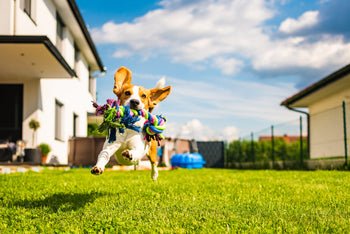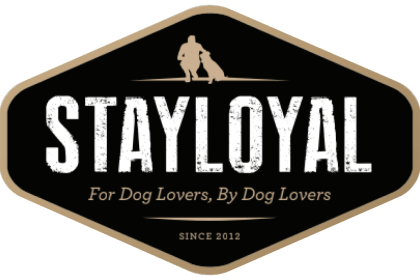When Dogs React and Training Breaks Down: Common Dog Threshold

Have you ever thought about your thresholds? The level at which point something in your environment becomes too much for you to handle? This can be anything from something physical (pain, cold, hot, noise, etc.) to emotional thresholds (anger, fear, stress, etc.). Think of the last time you got mad at someone – what was it that riled you to the point you lost your temper? Or, perhaps an easier analogy, at what threshold is water too hot for you? Maybe you can handle almost boiling or maybe anything over lukewarm is too hot for you.
Now what about your significant other? Maybe they are more or less sensitive to hot water than you. We all have different thresholds.
So do dogs.
And these thresholds are often what cause dog training to break down. If your dog is over their threshold for almost anything: distractions, fear, stress, pain, hunger, etc., they are not going to be able to concentrate on training. Often when an owner cannot get their dog to do something, it’s because they are past a threshold. This is when we usually call our dog “stubborn” or “stupid.” When in reality, they cannot physically react to a behaviour cue or “listen” to their owner because their body is in “survival mode.” They switched from the parasympathetic nervous system (calm, thinking state), to sympathetic (flight or fight). When the sympathetic system is “switched on,” a dog’s body is focused on survival, not sit-stay.
Common Dog Thresholds
When it comes to domestic dogs and the world we expect them to live in, there are a lot of things that can cause them to go over threshold.
Just like humans, each dog is going to have different threshold levels for things. An extreme example is a dog that has only known love versus one that has been a victim of abuse. Many dogs that have only known love let the kids climb all over them, tug their ears, pat the head – they are pretty tolerant. A dog that has been abused is going to react, sometimes aggressively, to a person that gets with in feet of them – not even close enough to touch.
These two dogs have very different thresholds when it comes to human contact or handling. And it’s understandable.
Aside from human touch/handling, here are a few other common dog thresholds and extreme examples of each:
Environmental Distractions: One dog can perform a recall, sit and stay in a crowded dog park. Another finds it hard to perform a sit at home when a window is in view.
Excitement: One dog can obey a behaviour chain: when the front door opens, he goes to his mat and lies down, waiting to be greeted by the guests. Another dog gets so wound up by guests he exhibits humping behaviour and runs around doing zoomies.
Noise: One dog can sit quietly while the baby screams, a repair man bangs on the door frame and the tv is blaring. Another dog begins to bark frantically and redirects by attacking his dog bed whenever the blender is turned on.
Movement: One dog ignores the cars going down the street, the bird running across the lawn and the skateboard going by. Another dog races after anything that moves, ripping the leash from your hands, or jumping over the fence to continue the chase.
Other Dogs: One dog loves the dog park; he understands other dogs’ body language and plays appropriately. Another dog (whether out of fear, anxiety, aggression, or a mixture), growls as soon as he sees another dog, even from a distance of 10 feet.
Strangers: One dog politely walks up to strangers and sits, waiting to be petted. Another dog tries to hide behind his owner on leash, and growls as the person walks by – he will bite if pressed (mostly likely out of fear).
These are just some examples. And every single one of these has dogs all over the spectrum. Some dogs might be in the middle, some have really low thresholds and some really high for each thing.
Where Do These Thresholds Come From?
Thresholds can be created by training and socialization, or they may be part of a dog’s genetic makeup. The latter is very hard to change, but they definitely can be with patience and correct training. For example, think about your teeth and hot/cold sensitivity. Most of us have pretty good thresholds for these. But what happens when you get a cavity? All of a sudden, you have a very low threshold for anything cold, and sometimes hot as well.
So…Can I Raise my Dog’s Threshold?
If a well-socialized, friendly dog, especially a young puppy in a fear period, is attacked by another dog, their threshold for dogs coming up to them can drop overnight. You may or may not be able to raise it again – it will take time, patience, and training.
Professional trainers can help you figure out which threshold your dog is crossing (sometimes it may be more than one!) and then how to get him back under it, so he can relax, be successful at learning, and hopefully raise that threshold.
For example, you take your young puppy to the park and you want to practice stay. There are kids running around, someone playing fetch with another dog and cars driving by. Your puppy, whose stay is rock solid at home, will not keep his butt on the grass for even a second. That’s because the environment is just too stimulating and he cannot concentrate on what you are asking. He is over his distraction threshold.
The fix? Take him somewhere less distracting, add distance between him and the things that are distracting, etc. Then slowly build up to more distractions, adding one at a time instead of a whole bunch. The key is to always keep him under, so he can be successful while raising the threshold.
Flooding is when you make an animal be exposed to something that causes them to react, with no way to escape. AVOID THIS. It’s how people get bitten or dogs get into fights. It causes learned helplessness and can actually make the threshold lower.
It’s Important to Remember Two Things
One, some thresholds you may not be able to change. If you have a dog with an over-active prey drive, you may never get him to a high threshold when it comes to moving things. You may get him better, say teach him to look back at you and “check in” to get a tasty treat when he sees a rabbit while leashed on a walk. But it might be that you can never let him off leash, as his sympathetic system will kick in and he will be gone. This isn’t always the case, but sometimes you may have to learn to manage your dog’s behaviour and do or not do things according to his thresholds. I have a friend whose dog gets something to chew on (long lasting) every time she vacuums because otherwise, he full-on reacts (barking, redirects by attacking the nearest fabric thing like a dog bed, toy, couch). He is 8 years old. The noise and the movement are just too much for him and, while training has gotten him to the point where he can ignore it and stay just under threshold with a distraction, he cannot handle it otherwise.
Two, we need to be respectful of a dog’s threshold. Just like we would hope our significant other wouldn’t put a tarantula on our shoulder when they know we get freaked out if we see a small spider three feet away from us, we should not knowingly put our dogs in situations that put them over threshold.
Being aware of thresholds and how they work can help you be more patient with your dog, as well as help you figure out things that may be hindering your training. And, at the end of the day, you may find management, such as the dog and the vacuum scenario, is the best solution so that both you and your dog can be happy.








